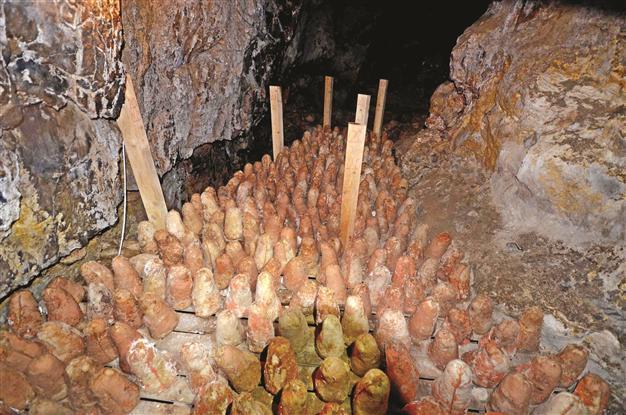Divle’s cheese competes with traditional French Roquefort
KARAMAN - Anatolia News Agency

Over the course of the six month period, a white mold covers the surface of the cheese first, and then the cheese finally turns red with the effect of the bacteria. AA photo
Divle Obruk cheese, which is produced with natural methods and stored in a 45-meter deep cave in the village of Üçharman in the Central Anatolian province of Karaman’s Ayrancı district, competes with French Roquefort cheese for flavor.Ayrancı Mayor Yüksel Büyükkarcı said the most outstanding aspect of Divle cheese is its organic quality, as it is made from the milk of sheep and goats that are naturally fed on mountains. ”Cheese pressed to a sheep or goat’s hide is placed in Divle potholes in May and June, and is kept there until the end of October. This cave is 256 meters long and 36 meters deep, with a temperature of four Celsius in all seasons. Over the course of the six month period, a white mold covers the surface of the cheese first, and then the cheese finally turns red with the effect of the bacteria,” Büyükkkarcı said.
Büyükkarcı claims that Divle Obruk cheese is among the top five cheeses in the world, and that its taste and appearance surpasses even French Roquefort cheese. “The only problem is [Divle Obruk’s] non-standardized production. If its production was standardized, I believe it would be a very popular cheese in terms of both trade and appearance.
You cannot see such a red tone in any other cheese. People from France and the Netherlands took bacteria from here but they could not produce the same bacteria,” he said.
Üçharman village’s headman, Cemal Kütahya, said the previous name of the village was “Divle.”
He said everyone in the global cheese trade was definitely familiar with the name of Divle Obruk cheese. “Our cheese is so famous that people from France and Netherlands come here only to buy that cheese. They come, research and go, and a brand emerged spontaneously,” Kütahya said.
French and Dutch experts visit village for cheese
Kütahya said Divle Obruk cheese had many unique features that made it different from other cheeses.
”Our region is situated on a mountainside. The locals of the village deal with stock farming. Our meadows are large and fruitful, and it is known that there are hundreds of endemic plant types there. Cheese production begins during April and early May. The milk of the sheep fed in meadows is kept in boilers for a while after being fermented. Then the fermented cheese is bagged and kept under the rocks for two days so that it dries completely. After that, the cheese is scrubbed and pressed on clean goat or sheep hide. Finally it is stored in the pothole until the autumn so that it doesn’t decay and gains a certain consistence,” Kütahya said.
Cheese turns red in pothole
“Other types of cheese are stored in cold stores everywhere. But our cold store is the cave, and Divle Obruk cheese takes its flavor from these potholes. The hide’s color becomes bluish after a month, then a white mold covers the surface of the hide, before it finally turns into a reddish color. This transformation occurs thanks to the pothole. When the cheese is cut, it can be seen that its inner parts are snow white. Even though you place a black tulum cheese there, its color turns to red after three months,” Kütahya said.
Kütahya also said that fake Divle Obruk cheese was sold in the markets.
“Sometimes we see that some people are selling the cheese stored in chill stores as Divle Obruk cheese, but there is no such thing. Consumers buy fake Divle Obruk cheese as they don’t know the original, and this discredits our name,” he said. “Those who want to consume original Divle Obruk cheese should see our village and pothole, and should observe the production of the cheese. They should look at its color. It is not possible to find this cheese everywhere, as it is not produced in great numbers.”
















